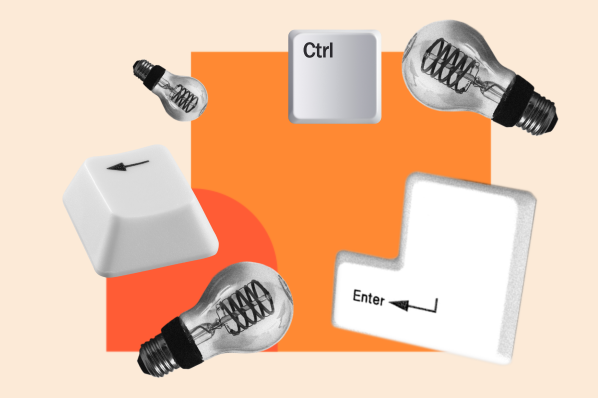To help you make the best decision for your business, we've compiled a list of 15 top backend technologies to learn in 2024. Backend technologies are essential to understand because they power the internet. Without backend technologies, we wouldn't be able to enjoy the internet as we know it today. Let's begin with defining backend technologies.
Table of Contents
What are backend technologies?
The backend is the server side of a website. It keeps and organizes data and ensures that everything on the client side of the website operates correctly. It's the part of the site you can't interact with or see. Backend developers create features and characteristics that are indirectly accessible to users through a front-end application. Back-end development includes writing APIs, developing libraries, and dealing with system components without user interfaces or scientific programming systems.
Backend developers are in charge of programming the business logic and collaborating with the front-end to deliver interconnected, functional, and valuable web apps. The primary responsibilities of a backend developer are as follows:
- Create the logical systems for all of the website's features.
- Maintain all project resources and libraries up to date.
- Create a database design that will properly store the data.
- Maintain all components of the website secure
Backend developers are in high demand in the world. Therefore, you should consider mastering backend programming languages such as Javascript, Golang, or Python to be well-versed and marketable.
Now that we've answered the question, "what are backend technologies," it's time to look at the list of 15 top backend technologies to learn in 2024.
Top 15 Backend Technologies

1. Java
What is Java?
Java is a versatile, object-oriented programming language that Sun Microsystems released in 1995. It shares many features with C++ but also has advanced and simplified capabilities. This language can be accessed for free and run on any platform. Some of the biggest tech companies in the world, including Amazon, Google, and Netflix all use Java.
Why learn Java?
Learning Java will make you a more well-rounded programmer. In addition, Java is one of the most popular programming languages in the world, so it is in high demand among employers. It may help you develop skills businesses are always searching for in their developers.
Java Features:
- Simple: Java has made life easier by eliminating all the difficulties of C++, such as operator overloading or pointers.
- Secured: The java bytecode is not understandable by a human after compilation. This prevents any untrustworthy sources from performing activities in the sandbox. It allows us to develop virus-free, tamper-free systems/applications.
- Dynamic: It supports dynamic memory allocation, minimizes memory waste, and improves the application's performance.
Pro Tip:
With so many frameworks available, such as Spring, Hibernate, Struts, GWT, JSF, Grails, Vaadin, and Blade, it's challenging to know which one to choose. Start with becoming proficient in just one framework.
2. JavaScript/Node.js
What is Node.js?
Node.js allows for JavaScript to be used on the backend of a web application and in a serverless architecture. This presents an exciting intersection of frontend and backend technologies, as JavaScript is traditionally only used on the frontend, client-side part of a web application.
Why learn Node.js?
Using JavaScript, Node.js makes it easy to send and sync data between the server and client sides. Using the same language will make your code cleaner and more consistent. You can use the same naming convention, tools, and best practices.
Node.js Features:
- Performance and Scalability: Node.js is based on the Chrome V8 engine, which Google develops. It enables Node to give a server-side runtime environment that compiles and executes JavaScript at breakneck speeds. Instead of interpreting it or executing it as bytecode, the V8 engine converts JavaScript into native machine code, giving Node an advantage in terms of speed over other languages like Python and Ruby.
- Scalable: Not only can NodeJs handle numerous requests simultaneously, and has a cluster module to balance out the load across all active CPU cores.
- Cross-platform compatibility: NodeJS is a versatile system that can be used on Windows, Unix, Linux, macOS X, and mobile devices. When paired with the right package, NodeJS can generate a self-sufficient executable.
Pro Tip:
If you're coming from a language with a lot of IDE integration, like Java or C#, developing Node.js applications may be difficult. To debug Node.js programs, execute node to launch the built-in debugger.
3. Python
What is Python?
Python is a high-level programming language that is popular for its clear syntax, object-oriented design, and ability to allow program developers to create applications rapidly.
Why learn Python?
Python is a programming language that has endeared itself to many professionals. Data scientists, software engineers, machine-learning experts, and hackers love Python because of its flexibility, adaptability, and object-oriented features.
Python Features:
- Smooth learning curve: Python has a minimal syntax that makes it easy to learn and use as a computer language. Python is easy to learn and utilize for novices and converts because it resembles ordinary English writing and reading.
- Automation: Python is known for its ease of automation due to the abundance of tools and modules. In software testing, Python excels in speed and efficiency with less code.
- Open-source libraries: Python has an active community that continues developing various open-source libraries and providing support for users. The vast number of available libraries means that Python is a great choice for almost any purpose.
Pro Tip:
Master the basics of Python before moving on to more complex concepts. Learn about lists, dictionaries, and sets, as these data structures will come in handy.
4. Ruby
What is Ruby on Rails?
Ruby is a well-known, versatile programming language regularly used for web scraping, site building, command-line tools, automation, and data processing. While you may have primarily heard of Ruby in association with Ruby on Rails - one of the most popular web development frameworks - it has many other applications. Ruby, released in 1995 by Yukihiro Matsumoto, is often called a "language of careful balance.".
Why learn Ruby?
Ruby is a versatile, in-demand programming language used for web development, scripting, data processing, DevOps, static site generation, and beyond.
Ruby Features:
- Convention over configuration: Ruby reduces the amount of code that developers need to write.
- ActiveRecord: Ruby has an ORM library that enables easy database interactions.
- MVC architecture: Ruby has a modular and scalable design.
Pro Tip:
Use existing gems instead of writing code from scratch for more optimized code.
5. PHP
What is PHP?
PHP, which stands for "PHP Hypertext Preprocessor," is a widely-used open-source server-side programming language that helps create dynamic web pages.
Why learn PHP?
PHP is a server-side programming language that has gained popularity over the years. PHP is an excellent language for creating dynamic web applications since it works well with HTML and databases.
PHP Features:
- Cybersecurity application: Cybersecurity often uses PHP to manage secure data sharing between servers and users, increasing security when transferring data.
- Diversity of output: It allows you to generate PDF, Flash, and simple text files without requiring any new languages. It can build forms that collect information from visitors, deliver dynamic page content, or send cookies that help identify returning visitors and start remarketing efforts.
- Ease of learning: PHP is similar to HTML and has built-in features and the capacity to reuse code blocks you create, making it easier to learn than other programming languages.
Pro Tip:
Make sure you have enabled error reporting if you're going to learn. It will save you a lot of time trying to navigate code you aren't necessarily familiar with, and you'll be grateful for it.
6. C#
What is C#?
C# is a Microsoft object-oriented programming language that enables constructing more complex programs. It developed from the necessity for a robust object-oriented language. C# is a 2002 release that has many applications, including web development, desktop applications, and all phases of scripting languages.
Why learn C#?
C# is a widely used programming language utilized for various applications, including mobile apps, game creation, and business software.
C# Features:
- Type safety: C# enables type checking at compile time, which helps to prevent errors during runtime.
- Memory management: C# manages memory automatically, which helps to prevent memory leaks.
- Support for LINQ: C# enables easy data manipulation and querying.
Pro Tip:
Write a small program (or expand an existing one) in which you reinforce the learning with applied practice.
7. C++
What is C++?
C++ is an object-oriented programming language designed to have a low level of system dependence. It was released in 1985 by Bjarne Stroustrup. C++ is so compatible with C that it will probably compile over 99% of C programs without changing a line of source code. Though C++ is a well-structured and safer language than C, it is Object-Oriented Programming (OOP) based.
Why learn C++?
C++ is a powerful programming language nearly identical to C and will run most C programs unaltered. However, C++ is a much safer language for systems programming and game development than C as it uses object-oriented programming principles.
C++ Features:
- Speed and high-performance: C++'s quickness has made it a favorite of software developers everywhere. As an upgraded form of low-level C language, C++ can be a complex language to learn for beginners, but it is powerful and versatile. If you are interested in learning C++, we recommend finding a good tutorial or course that will walk you through the basics of the language. Once you understand the basics, you can begin working on projects to practice your skills.
- Platform-independent: The portability of C++ allows developers to write software that can be run on many different operating systems without needing to change the source code.
- Memory control: C++ provides functions that help developers manage memory more efficiently, including dynamic memory allocation and pointers.
Pro Tip:
C++ can be challenging for beginners, but it is compelling and versatile. If you are interested in learning C++, we recommend finding a good tutorial or course that will walk you through the basics of the language. Once you understand the basics, you can begin working on projects to practice your skills.
8. Kotlin
What is Kotlin?
Kotlin is a language that runs on multiple platforms, is concise, safe, interoperable, and is easy to use with tools. It is a statically-typed programming language that primarily uses the Java virtual machine as well as JavaScript or LLVM compiler infrastructure.
Why learn Kotlin?
Kotlin's popularity among developers stems from its straightforward syntax and extensive features. Kotlin has a compact codebase that makes it a stable and consistent language for code development. You can easily detect codes at compile time which can be resolved before running the code.
Kotlin Features:
- Write less code: When done correctly, less code equals fewer bugs. You may concentrate on more essential things when you delegate routine chores to the framework.
- Fully compatible with Java: The beauty of Kotlin is that Android developers can continue using all Java frameworks and libraries while also writing more concise code. In other words, you don't have to choose between two languages when building a mobile product. Plus, migrating your applications from Java to Kotlin down the line is always an option.
- Concise: Drastically reduce the boilerplate code you need to write. With inferred syntax, you can often declare variables without explicitly stating their type. This eliminates entire classes of errors before compilation even happens.
Pro Tip:
Use an IDE that supports Kotlin, such as IntelliJ IDEA or Android Studio. Also, consider using a build tool such as Gradle or Maven.
9. Scala
What is Scala?
Created in 2001 by Martin Odersky and his team, Scala is a general-purpose JVM programming language with its first public release in 2004. Scala is a high-level language that combines functional and object-oriented programming with high-performance runtimes. Scala is a powerful language that can use many of the same capabilities as Python, including building machine learning models.
Why learn Scala?
Scala is different from Java because it supports two programming paradigms: object-oriented (OOP) and functional programming (FP). It's beneficial to master at least one language from several paradigms, such as imperative, logical, functional, and OOP, so you can compare and contrast them.
Scala Features:
- Scalable: The design of Scala aims to address the difficulties that can come with building large-scale applications.
- Functional: Scala is a functional programming language, which means that functions are first-class values. This allows for more concise and readable code.
- Object-Oriented: Scala is also an object-oriented programming language that supports encapsulation, inheritance, and polymorphism.
Pro Tip:
Scala isn't particularly easy to learn if you're a novice. Starting with a basic language like JavaScript or Python would be beneficial. Choose Scala when you need specialized libraries for concurrent distributed applications.
10. Perl
What is Perl?
Perl is a general-purpose, high-level, interpreted, and dynamic programming language. Larry Wall developed it in 1987. There is no official Full form of Perl, but the most used expansion is “Practical Extraction and Reporting Language. “
Why learn Perl?
Since Perl is syntactically similar to other widely used languages, it is easier to code and learn in Perl. Programs can be written in any text editor, such as Notepad++.
Perl Features:
- Text-Processing: Perl, a high-level programming language, has remarkable text manipulation capabilities that allow it to quickly produce reports from several text files. It can also convert files to other formats.
- System Administration: Perl is a powerful scripting language that makes system administration tasks easy. With Perl, you can complete all your system administration tasks in one language instead of becoming dependent on many languages. Perl isa versatile language used for web programming, web automation, and GUI programming.
- Easy to start: Perl is a high-level language that resembles other standard programming languages such as C and C++. As a result, Perl is easy to learn for anyone interested in coding.
Pro Tip:
Perl doesn't require or suggest any particular programming approach, such as procedural, object-oriented, or functional—the interpreter and its functions serve as a single language definition.
11. Go (aka Golang)
What is Go?
Go, or Golang, is a Google-originated open-source programming language. The creators of Go wanted developers to have a programming language that allowed them to create applications quickly and easily. Go is used in servers, web development, and command-line interfaces and aims to be simple, high-performing, readable, and efficient.
Why learn Go?
Learning Go will be a piece of cake if you have prior experience with coding languages such as C or Java. Despite this preexisting knowledge, Go is globally recognized as simpler to learn than its competitors.
Go Features:
- Easy learning curve: With its simple syntax and minimal structure, Go is easy to understand even if you are inexperienced in computer languages.
- Built-in concurrency: One of the main reasons for choosing Go is its built-in support for concurrency, which allows multiple processes to run simultaneously.
- Robust standard library: The standard library provides developers with a vast amount of reliable and well-tested code.
Pro Tip:
If you want to work in the cloud-based programming industry, Go is an excellent language to learn. Amazon Web Services, Kubernetes, and Google Cloud Platform (GCP) all support Go, making it a good choice for those seeking a profession in this area.
12. SQL
What is SQL?
SQL (Structured Query Language) is a programming language that allows us to manage relational databases. A relational database is a kind of database that keeps track of and makes available data points connected. We can store information in a SQL table and access or change it.
Why learn SQL?
SQL programming language is becoming increasingly popular due to its usefulness in data processing. Based on reports from overseas job portals and Geeks For Geeks, those with a mastery of SQL will be highly sought-after in the year 2022. The ease of learning and beginner-friendliness makes it an ideal choice for anyone looking to get into coding or data processing.
SQL Features:
- Centralized Database Control: The database control is directly integrated into the program. As a result, there's virtually no chance of data corruption or human error during the loading process.
- Data Recovery and Restore Features: SQL Server also has data recovery and restore features, which can be used by programmers and developers when there is a problem with processing data in a database.
- Database Security Management: In addition to its powerful security capabilities, Microsoft SQL Server has excellent data protection management. There is no doubt that, especially when using a password that will be challenging to crack, the security of your database is considerably more secure.
Pro Tip:
Understanding and researching SQL concepts and syntax is an essential skill for any self-respecting programmer. The SQL reference guide is an excellent way to study and familiarize yourself with the language. These guides usually contain everything you need to know about the language, from its syntax to programming best practices.
13. Spring Boot
What is Spring Boot?
Spring Boot is a micro Service Java-based open-source framework created by the Pivotal Team and used to develop stand-alone and production-ready spring applications. It is a backend framework that allows you to bootstrap your application quickly. By using Spring Boot, you can skip a lot of boilerplate code.
Why learn Spring Boot?
Spring Boot is an excellent way for Java developers to create stand-alone, production-grade Spring applications that are easy to run. You can get started with minimal configuration without needing a complex Spring setup.
Spring Boot Features:
- Compatible with Containers: Spring Boot applications are easily deployed in containers such as Docker.
- Embedded Servers: Spring Boot comes with embedded servers, making running your applications easy.
- Minimum configuration: You can start with Spring Boot with minimal configuration. You don't need a complex Spring setup.
Pro Tip:
Dependency management is a tricky problem for large projects. Spring Boot solves this issue by providing a set of dependencies that saves time and trouble.
14. ASP.NET Core
What is ASP .NET Core?
ASP.NET is a Microsoft-developed open-source software for building web apps, services, IoT apps, and mobile backend components. It allows .NET development companies to construct internet applications, services, IoT apps, and mobile backends. The primary distinction between ASP.NET and ASP.NET Core is that they are cross-platform. By the way, it enables us to run on .NET Core or net Framework.
Why learn ASP .NET Core?
ASP.NET Core is a re-imagined version of the ASP.NET framework, built on top of the new .NET Core platform, that uses modern software design ideas. Although it is new in one way, .NET Core has years of widespread production usage. It has incorporated many features from the mature, stable, and reliable .NET Framework, which has been in use for almost two decades.
ASP .NET Core Features:
- Web Apps and Services: You can create efficient and reliable web apps with HTML, CSS, and Javascript.
- Run .NET in Browser: With Blazor, we can use C# to create interactive web UIs that run .NET directly in the browser.
- Internet of Things: You can develop cutting-edge applications or background services for IoT devices.
Pro Tip:
Use .NET Core for your server application when you need side-by-side versions of .NET per app, target microservices, use Docker containers, or have cross-platform needs.
15. Django
What is Django?
Django is an open-source python web framework that helps you develop websites quickly, securely, and with clean design. It is a web application framework that provides all the components needed for app development so you can focus on new features instead of rewriting old code. Instagram, BitBucket, Mozilla, and other well-known websites are all created with the Django framework.
Why learn Django?
The Django framework is a wonderful choice if you're creating your software because it's a web framework with many essential features already included, so you won't have to write them yourself. This implies that you can create an app more quickly.
Django Features:
- Easy to use: The Django framework uses the Python programming language, which has been gaining popularity among programmers in recent years. Widely used its applications are free and open-source, developed and maintained by a large community of developers.
- Fast and simple: Django takes advantage of rapid development principles, allowing developers to work on several iterations at once without having to start from the beginning.
- Excellent documentation: While many frameworks rely on an alphabetical list of modules, attributes, and methods, Django's extensive documentation makes it easy to develop different real-world applications.
Pro Tip:
Start by becoming proficient in Python and work on a small project. After that, learn Django.
Which backend technologies should you learn first?
If you're looking to learn a backend programming language, any of the languages on this list would be a good choice. Many of these languages are in high demand and show no signs of slowing down. With so many options, deciding which language to learn can be tough. Our advice is to start by becoming proficient in one of the top 5 on the list and work on a small project. After that, learn some of the correlating frameworks. Once you're comfortable with those, you can start exploring other options on this list.
.png?width=112&height=112&name=Image%20Hackathon%20%E2%80%93%20Vertical%20(50).png)




![7 Effective Ways to Track Changes on a Website [+ Best Tracking Tools]](https://53.fs1.hubspotusercontent-na1.net/hubfs/53/track-changes-website.webp)

.jpg)

